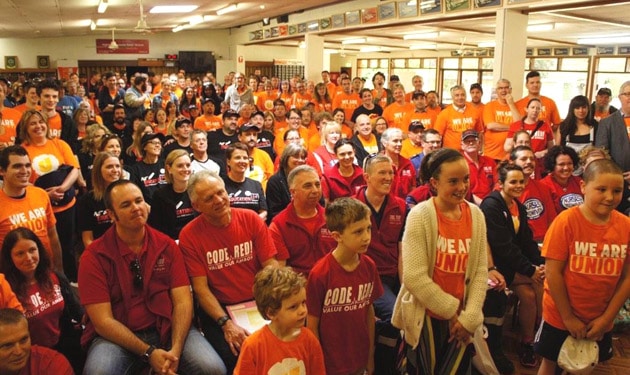The Liberals’ defeat after one term in Victoria is a major blow to Tony Abbott. Denis Napthine’s government has become the first one-term government in Victoria since 1955, in a defeat for his cuts to TAFE and war on public sector workers. Labor’s success in Victoria increases the chances of getting rid of Abbott and boosts the confidence of unions to push for real wage increases, defend jobs and stand up to Abbott’s cuts.
Abbott’s deeply unpopular budget and his continuing attacks—such as the cuts to the ABC and the petrol tax increase that were announced during the Victorian campaign—clearly hurt Napthine. Abbott even raised the possibility of increasing the GST in the run up to the election.
One of the features of the election was the significant union mobilisation around public services, including the bitter ambulance drivers’ dispute. In a relentless marginal seats campaign, firefighters, nurses and teachers door-knocked and argued one-on-one with voters about why the Liberals had to go.
The efforts from the Liberals and the Murdoch media to brand Labor as controlled by the unions fell flat. In a refreshing change from the union bashing efforts of many recent Labor leaders, Labor’s new Premier Daniel Andrews even boasted on election night that, “There are some that wanted [the election] to be all about unions and workers, and that is exactly what it was”.
The union campaign has pushed Daniel Andrews and Victorian Labor to the left. Andrews has already said he will end the “war against paramedics” and end the need for productivity trade-offs for all public sector pay rises over 2.5 per cent.
‘We are union’
The unions’ marginal seats campaign has attracted a lot of interest. Its strength was the way Victorian Trades Hall’s “We are union” campaign put the unions and working class issues front and centre in the election (federal Labor leader Bill Shorten take note!).
But the actual results were mixed. In some seats there was a bigger than average swing; in others it was less than average. In fact, the Liberals have been behind Labor in Victoria since 2012, except for a couple of months after Napthine replaced the hapless Ted Baillieu in March 2013.
The unions’ effort was modeled on the electoral element of the Your Rights at Work campaign. The union leaders say they want to replicate such a campaign in both the upcoming Queensland and New South Wales state elections and the next federal election.
But the federal election is two years away. We can’t wait that long to fight Abbott’s cuts, or his new laws targeting union rights. The marginal seats strategy meant putting the unions’ resources almost solely into an electoral campaign.
But in June, Victoria unions led the fight against Abbott with 20,000 workers striking and marching to “Bust the Budget”. That kind of mobilisation could have won the Ambos campaign months ago.
It will be strikes and demonstrations that will stop Abbott implementing more cuts, or bringing in a Medicare co-payment in the next two years. And it will be industrial action that will be needed to keep Andrews to his promises to create 100,000 jobs and boost funding and restore TAFE.
Disappointingly, The Greens’ overall vote went down slightly. But they have won their first Victorian lower house seat in Melbourne. The Greens will also have a share in the balance of power in the upper house, where Labor will be without a majority.
This will help keep the pressure on Labor to tear up the contracts for the East-West Link toll road and should mean there is some greater pressure from the left.
But the Greens’ gains in the inner city were mainly the result of an increasingly efficient electoral machine developed for the campaigns of federal MP Adam Bandt. The Greens’ policies on issues like TAFE and hospitals are well to the left of Labor’s. But until they identify as clearly with industrial struggles as they do environmental issues, it will remain hard for the party to out-flank Labor and win increased support in working class areas.
The Greens’ decision to preference the Palmer United Party ahead of Labor in upper house divisions also did nothing to help them appeal to left-wing Labor voters.
The election mobilisation in Victoria that put 1500 unionists on polling booths needs to be translated into industrial mobilisation nationally. The result will boost the confidence of workers everywhere, including the federal public sector workers fighting wage cuts that Abbott wants to impose. Every union needs to get behind their fight.
As Abbott’s next budget approaches we need to step up the fight again. March in March rallies are starting to be planned for the new year, and this time we need the rallies to have real union contingents. The Victorian campaign shows that workers are more than willing to fight.






